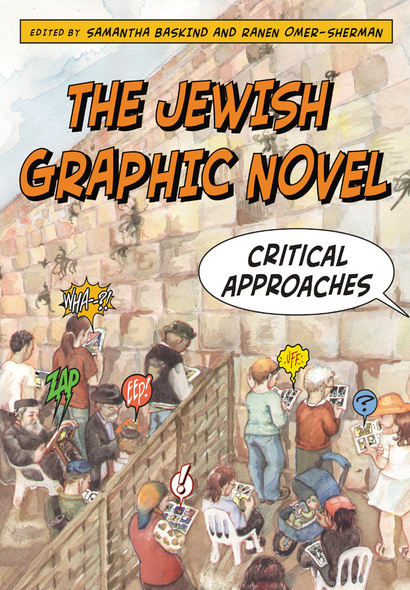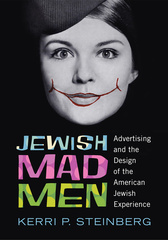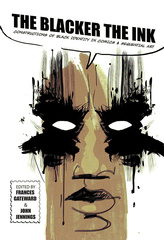
328 pages, 6 7/8 x 10
87 illustrations
Paperback
Release Date:19 Jan 2010
ISBN:9780813547756
The Jewish Graphic Novel
Critical Approaches
Rutgers University Press
In the 1970s and 1980s Jewish cartoonists such as Will Eisner were some of the first artists to use the graphic novel as a way to explore their ethnicity. Although similar to their pop culture counterpart, the comic book, graphic novels presented weightier subject matter in more expensive packaging, which appealed to an adult audience and gained them credibility as a genre.
The Jewish Graphic Novel is a lively, interdisciplinary collection of essays that addresses critically acclaimed works in this subgenre of Jewish literary and artistic culture. Featuring insightful discussions of notable figures in the industryùsuch as Will Eisner, Art Spiegelman, and Joann Sfarùthe essays focus on the how graphic novels are increasingly being used in Holocaust memoir and fiction, and to portray Jewish identity in America and abroad
Featuring more than 85 illustrations, this collection is a compelling representation of a major postmodern ethnic and artistic achievement.
A major contribution to the literature on graphic novels. Highly Recommended.
The People of the Book—the epithet is no longer sufficient. More appropriate: The People of the Book and the Image. Samantha Baskind and Ranen Omer-Sherman, leading a cadre of exegetes, explain what makes the combination Jewish.
Will Eisner coined the term 'Graphic Novel' in 1976 for A Contract with God, his account of the Jewish Diaspora experience. It has since become the label for complex illustrated texts—some fiction, somenon-fiction; most a striking mix of both. The growth of the 'GraphicNovel' also tracks with the rise of a post-modern, global Jewish culturein the later 20th century. The Jewish Graphic Novel is thus both a history of the genre as well as a history of its particular place in the growing, self-conscious world of contemporary Jewish self-representation. A brilliant and original book!
A lively, interdisciplinary collection of essays that addresses critically acclaimed works in this subgenre of Jewish literary and artistic culture. This comprehensive volume is a compelling representation of a major postmodern ethnic and artistic achievement.
Those interested in current Jewish literary culture will find it absorbing, as will anyone interested in how the graphic novel contributes to our understanding of Jewish identity.
Few attempts have been made to publish an anthology of academic essays on Jewish graphic novels. The Jewish Graphic Novel is a wonderful attempt to fill this void. The collection brings together four essays on specific books, five essays comparing pairs of graphic narratives, two overviews, two cartoonist interviews, an in-depth look at a Jewish comic book character, and an illustrated essay about Jewish biographical comix. Highly recommended for public, academic, and high school libraries, particularly those that already have significant Judaica graphic novel collections.
The graphic novel is a vital and emerging genre, and this is the onlybook that focuses on its relation to Jewish culture, literature, and history. A highly readable and informative collection that will be of great interest to readers across a wide range of disciplines.
The Jewish Graphic Novel is a pivotal work of sequential art scholarship: the 16 essays in this volume provide an excellent introduction to an understanding of Jewish experience and culture through the lens of comics. Baskind and Omer-Sherman have produced an original collection of articles that provide new insights into the history and culture of the graphic novel, its writers, and artists.
Those who find themselves involved with graphic genres will find this book a welcome resource. It is a strong collection.
SAMANTHA BASKIND is an associate professor of art history at Cleveland State University. She is the author of Raphael Soyer and the Search for Modern Jewish Art.
RANEN OMER-SHERMAN is Gabelli Senior Scholar of Arts and Sciences and a professor of English at the University of Miami. He is the author of Israel in Exile: Jewish Writing and the Desert.
RANEN OMER-SHERMAN is Gabelli Senior Scholar of Arts and Sciences and a professor of English at the University of Miami. He is the author of Israel in Exile: Jewish Writing and the Desert.
Foreword: Comix, Judaism, and Me/ J. T. Waldman
Introduction / Samantha Baskind / Ranen Omer-Sherman
Part One. The Jewish American Experience Contemporary American Jewish Comic Books: Abject Pasts, Heroic Futures / Laurence Roth
Comic Books, Tragic Stories: Will Eisner's American Jewish History / Jeremy Dauber
``Wanna watch the grown-ups doin' dirty things?'': Jewish Sexuality and the Early Graphic Novel / Josh Lambert
``Give `em another circumcision'': Jewish Masculinities in The Golem's Mighty Swing / Roxanne Harde
Part Two. The Holocaust across Borders A Tale of Two Mice: Graphic Representations of the Jew in Holocaust Narrative / Lisa Naomi Mulman
``When time stands still'': Traumatic Immediacy and Narrative Organization in Art Spiegelman's Maus and In the Shadow of No Towers / Erin McGlothlin
The Holocaust without Ink: Absent Memory and Atrocity in Joe Kubert's Graphic Novel Yossel: April 19, 1943 / Brad Prager
Releasing the Grip of the Ghostly: Bernice Eisenstein's I Was a Child of Holocaust Survivors / Miriam Harris
Witness, Trauma, and Remembrance: Holocaust Representation and X-Men Comics / Cheryl Alexander Malcolm
Part Three. The Graphic Novel outside the United States Imperfect Masters: Rabbinic Authority in Joann Sfar's The Rabbi's Cat / Paul Eisenstein
Borderlands: Places, Spaces, and Jewish Identity in Joann Sfar's The Rabbi's Cat and Klezmer / Marla Harris
From Darkness into Light: Reframing Notions of Self and Other in Contemporary Israeli Graphic Narratives / Ariel Kahn
Ben Gurion's Golem and Jewish Lesbians: Subverting Hegemonic History in Two Israeli Graphic Novels / Alon Raab
Part Four. Jewish Graphic Novelists in Their Own Words and Pictures A Conversation with Miriam Katin / Samantha Baskind
A Conversation with Miriam Libicki / Ranen Omer-Sherman
Jewish Memoir Goes Pow! Zap! Oy! / Miriam Libicki
Further Reading
Notes on Contributors
Index
Introduction / Samantha Baskind / Ranen Omer-Sherman
Part One. The Jewish American Experience Contemporary American Jewish Comic Books: Abject Pasts, Heroic Futures / Laurence Roth
Comic Books, Tragic Stories: Will Eisner's American Jewish History / Jeremy Dauber
``Wanna watch the grown-ups doin' dirty things?'': Jewish Sexuality and the Early Graphic Novel / Josh Lambert
``Give `em another circumcision'': Jewish Masculinities in The Golem's Mighty Swing / Roxanne Harde
Part Two. The Holocaust across Borders A Tale of Two Mice: Graphic Representations of the Jew in Holocaust Narrative / Lisa Naomi Mulman
``When time stands still'': Traumatic Immediacy and Narrative Organization in Art Spiegelman's Maus and In the Shadow of No Towers / Erin McGlothlin
The Holocaust without Ink: Absent Memory and Atrocity in Joe Kubert's Graphic Novel Yossel: April 19, 1943 / Brad Prager
Releasing the Grip of the Ghostly: Bernice Eisenstein's I Was a Child of Holocaust Survivors / Miriam Harris
Witness, Trauma, and Remembrance: Holocaust Representation and X-Men Comics / Cheryl Alexander Malcolm
Part Three. The Graphic Novel outside the United States Imperfect Masters: Rabbinic Authority in Joann Sfar's The Rabbi's Cat / Paul Eisenstein
Borderlands: Places, Spaces, and Jewish Identity in Joann Sfar's The Rabbi's Cat and Klezmer / Marla Harris
From Darkness into Light: Reframing Notions of Self and Other in Contemporary Israeli Graphic Narratives / Ariel Kahn
Ben Gurion's Golem and Jewish Lesbians: Subverting Hegemonic History in Two Israeli Graphic Novels / Alon Raab
Part Four. Jewish Graphic Novelists in Their Own Words and Pictures A Conversation with Miriam Katin / Samantha Baskind
A Conversation with Miriam Libicki / Ranen Omer-Sherman
Jewish Memoir Goes Pow! Zap! Oy! / Miriam Libicki
Further Reading
Notes on Contributors
Index






